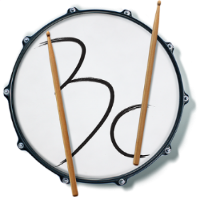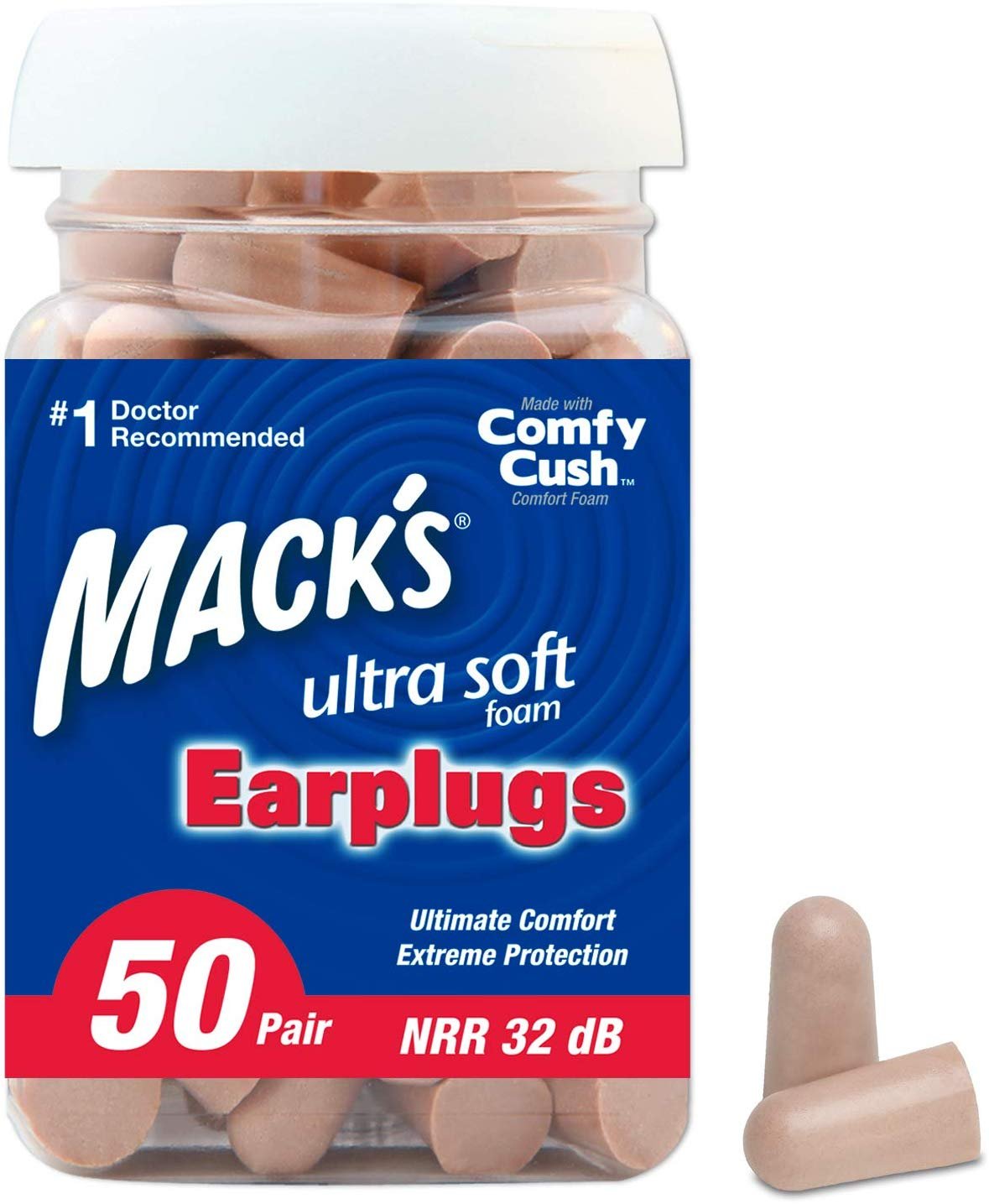Turn Down the Volume: The Importance of Hearing Protection
Did you know that drums are loud? Yup, they’re loud. Really loud. Like, loud enough to easily damage your hearing permanently if you don’t take the proper precautions. And it takes a lot less than you’d think to cause some damage to your hearing. Saying all of this isn’t meant to scare you, but if you’re playing on acoustic drums, you run a very real risk of harming your ears unless you use some form of hearing protection.
The Miracle of Hearing
Sound travels into your ears through tiny hairs that line your ear canals. These hair cells detect the vibrations of sound and help translate it into a signal that our brain can interpret. Generally, the human hearing range is between 20 and 20,000 Hertz (Hz - not the rental car company), but this range slowly diminishes with age.
Drum sets (and music as a whole) encompass a broad range of frequencies, typically between 50 Hz and 15k Hz, depending on tunings and cymbals used. But the sounds themselves have many different components. For example, the attack on a bass drum (the sound of the beater striking the head), might clock in at 115 Hz, but the drum might resonate at 75 Hz. A drum’s tuning ultimately determines the specific frequency bands it’ll encompass.
Some general dominant frequencies for drums and cymbals are as follows: Bass drums typically range from 50 Hz - 150 Hz, snare drums from 120 Hz - 250 Hz, rack toms from 100 Hz - 500 Hz (depends on drum size and tuning), floor toms from 60 Hz - 120 Hz, hihats from 300 Hz - 3k Hz, ride cymbals from 300 Hz - 600 Hz, and crash cymbals from 300 Hz - 500 Hz (also depending on size). There are many other frequencies present extending beyond these ranges that support the sounds of the drums and cymbals. Audio engineers will often boost higher frequencies from the cymbals (usually in the 10k Hz - 17k Hz range) to add more of a shimmery sheen to the sound. But these outer frequencies aren’t nearly as obvious. However, if certain frequency ranges are louder than others, you’re more likely to experience hearing loss in those ranges.
The intensity of a sound is measured in decibels (dB). Decibels are a logarithmic unit of measurement, meaning that small increases in the numerical value correlate with exponential increases of intensity. For example, a sound that is 90 dB is 10 times more intense than a sound at 80 dB. The duration of exposure to a noise greatly factors into the onset of hearing loss, as well as the distance from the sound. The closer and longer you’re exposed to loud sounds, the more significant the damage becomes.
The Danger of Sound
Have you ever had muffled hearing after going to a concert where you didn’t wear ear plugs? Ta-da! Your hearing got damaged! Hopefully, it went back to normal after a few hours or overnight, but repeated exposure to loud sounds will have a more pronounced and permanent impact. You just won’t notice it until the damage becomes severe...
Drum sets can create sounds anywhere from 90 dB to as high as 130 dB, depending on how hard the drummer is hitting, which parts of the kit are getting used more, and how close the listener is to the sound. Rim shots on a snare drum can clock in as high as 120 dB, while certain cymbals can reach up to 125 or 130 dB in close quarters. That’s loud enough to damage your hearing in a matter of seconds! For reference, a car horn is about 110 dB, and a jackhammer is closer to 130 dB. That is LOUD. According to this source, we can only withstand 1 second (literally!) of exposure to a sound at 127 dB without hearing protection before damage begins to occur. Even at 115 dB, hearing damage can occur after about 30 seconds. The snare drum and cymbals, particularly hihats and china cymbals, are the biggest offenders of causing hearing damage among drummers.
Symptoms of hearing loss aren’t immediately obvious until significant damage is done. Over time, certain pitches or frequency ranges get dulled, you might have trouble holding conversations if there’s a lot of background noise, or you may begin experiencing a persistent ringing in your ears (tinnitus). These symptoms can have an extremely negative impact on your quality of life and there’s no way to reverse them. Obviously, you don’t want to have to go through any of that, especially as a result of something fun like playing the drums! Thankfully, there are many preventative measures we can take to ensure drumming and music never harm our ears.
(Fun fact: the sound of a rocket launch would kill you from a much greater distance than the flames coming from the engines could!)
Foam Ear Plugs
No, stuffing toilet paper into your ears doesn’t count as meaningful hearing protection. But foam ear plugs from the pharmacy do! You can usually buy a container of 50 pairs for about $10 (like the one to the right). Most foam ear plugs cut around 32 dB. While they’ll protect your ears, they tend to boost lower frequencies and muddle a lot of details in sounds. As a result, they’re certainly not the #1 choice among musicians, but some hearing protection is absolutely better than none! Vocalists and guitarists might complain that they can’t hear certain frequency ranges, especially higher pitches, with foam ear plugs. It’s a common excuse used to avoid wearing them, which is pretty silly since there’s no harm that comes from using them. The only danger comes from NOT using them! It’s always good to have a pair on hand - you never know when you might need them.
High Fidelity Ear Plugs
Is the ultra bass-heavy sound from the foam ear plugs drowning out too much detail? High fidelity ear plugs are the next tier up. “Hi-fi” ear plugs might seem like a silly concept, but we can compare the difference between foam ear plugs and high fidelity ear plugs to the differences between a television from 1994 compared to a modern 4K TV. Yeah, you can still watch shows and movies on the 1994 TV, but the picture will be way fuzzier compared to the fancy-pants TVs of today. High fidelity ear plugs reduce the decibel level of sounds, typically between 16 and 26 dB (depending on the brand and model) without distorting any frequencies. I’ve been using Earasers (pictured left) for the past few years and was surprised how much clearer everything sounded compared to foam ear plugs. However, foam ear plugs come with a greater decibel reduction. While they’re marginally more expensive, coming in at around $50 per pair on their website (though most places sell them for $40), high fidelity ear plugs are a solid investment for drummers, musicians, and concertgoers.
Isolation Headphones
Want to play along with music and protect your hearing at the same time? Isolation headphones are the ideal solution. Important to note: regular headphones that you’d use for listening to music do not offer any meaningful hearing protection. You’ll end up turning up the music really loud to hear it over the drums, which is just another way to harm your hearing. These Vic Firth headphones (pictured right) are designed specifically for drummers and musicians, offering 25 dB reduction. They allow you to listen to music without having to blast the track to hear it over the drums. However, they’re a bit snug and can make your ears a bit sore after wearing them for a long time. But that’s how you know they do a good job protecting your ears!
In-ear Monitors
Offering the comfort and clarity of high fidelity ear plugs with the benefit of functioning as headphones, in-ear monitors are what all the pros use on stage during gigs. They’re especially helpful if you’re playing a drum set that’s all mic’d up. Some forms of hearing protection can cause sounds to bleed together, leading to drummers playing extra hard to hear themselves. But they just end up overplaying and drowning out other parts of the band without realizing it. With in-ears, you can have the signals from the drum mics go straight into your ears, making it much easier to hear yourself as you play. You can even have the signal from other instruments on stage go into your in-ears mix, allowing you to easily hear every other part of the band, too. They also cut up to 37 dB - even better than most foam ear plugs! If you decide to go this route, it’s best not to skimp on a junky $20 set that offers no actual protection. While the priciest option so far, something like these sound isolation in-ear monitors offer a superior balance between protection and functionality.
Custom Molds
Nothing can protect you as well as having customized ear plugs or in-ear monitors molded to fit your unique ears. All of the above products will protect you just fine, but they simply can’t compare to something designed specifically for you. Of course, since custom protection is the most effective choice, it’s also the most expensive. Getting custom molds requires a visit to a professional audiologist (a doctor), who will then work with a manufacturer (like Westone or Ultimate Ears) to ensure everything fits and works properly. The average drummer really doesn’t need custom in-ear monitors, but if you’re gigging a lot and playing on bigger stages where you can’t just rely on hearing your bandmates through their amps, they’re certainly a huge quality-of-life improvement. The better you can hear yourself and your bandmates on stage, the better you’ll be able to balance your volume as you play.
Overall, wearing hearing protection when you play the drums is the single best preventative measure you can take to ensure you don’t sustain hearing damage. Even with today’s medical advancements and technology, hearing loss is permanent. But you won’t ever need to worry about the drums wrecking your ears as long as you wear protection! Whether you wear foam ear plugs, isolation headphones, or in-ear monitors molded to fit you specifically, any form of hearing protection is better than nothing to ensure healthy hearing for years to come.







